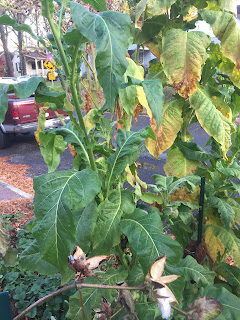Many more decades would pass before I witnessed a cotton plant, growing in a friend's garden in Durham this past fall. It had been planted for fun, not for the cotton, but it's impressive how much cotton the plant produced, and how much the cotton on the plant looks like the cotton you buy.
Before the cotton boll opens up to reveal the cotton, the clasping sheath at the base can be seen to resemble
the capsules of our native rose mallow hibiscus that grows along the shores of Lake Carnegie. The plants are in fact related, both being in the plant family Malvaceae (mal-VEH-cee-ee), along with okra and cacao. Genetic analysis has also put our native basswood trees, Tilia americana, in the Malvaceae family. Doing some reading, it was surprising to learn that the two most widely grown species of cotton are native to the Americas (as are peanuts, for that matter).
Standing next to the cotton plant in the North Carolina garden was another species native to the Americas: tobacco, also grown on a lark.
Tobacco is in the nightshade family, Solanaceae, along with tomatoes, potatoes, eggplant, and peppers. Some members of the family that pop up on their own around Princeton are the nightshades, ground cherry, and Jimsonweed. Once one knows about familial relatedness among seemingly disparate plants, it's fun to look for similarities of form in flower or leaf, and begin to see a web of connection in the plant world.






No comments:
Post a Comment